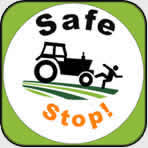Many serious incidents on farms involve machinery, often during maintenance or unblocking. In maintenance work, conditions are very different from those normally encountered and new hazards may be introduced. It is essential that everyone involved is trained to be aware of the hazards and the correct precautions to take to prevent harm.
- Safe Stop
- Before you start maintenance work
- Dealing with blockages or other problems
- Isolating equipment
- Pressurised plant
Safe stop

- Engage handbrake
- Controls in neutral
- Switch off engine (or turn off power)
- Remove key (or lock-off the power supply)

Follow Safe Stop:
- before leaving the driver's seat/operating position;
- when anyone else approaches;
- before anyone carries out maintenance, adjustments or deals with a blockage.
Before you start maintenance work
When you are planning to carrying out maintenance operations follow the 'safe stop' procedure and make sure:
- all movement has stopped before removing any guards;
- workers are properly trained to do the job;
- adequate tools, instructions, and manuals are provided for maintaining, adjusting, cleaning and unblocking machines;
- safe working practices are devised and used;
- stored energy, eg from compressed material, springs or hydraulics, is released safely before you start work;
- machines or parts supported by hydraulics are prevented from descending by using mechanical devices such as stops or jacks when people work under them.
Dealing with blockages or other problems
- Always follow the Safe Stop procedure before carrying out any intervention.
- Secure anything which could fall on you, eg by using props or scotches on tailgates/doors.
- Secure anything which could move or rotate, eg by using chocks.
- Remember that energy is stored in springs or hydraulics, for example. Consider how will you stop this energy being released or release it safely.
- Use the right tools for the job. Remember, machine components may suddenly move when a blockage is cleared.
- Follow the manufacturer's instructions/procedures, eg as set out in the operator's manual.
- Use built-in ladders and other purpose-designed access points and platforms where provided. Where such facilities don't exist you will need to consider alternative safe means of access, eg with measures provided to prevent falls.
- When the job is finished, always replace the guards before running the machine.
- Check the machine over and make sure people are well clear before restarting.
Isolating equipment
Isolate machines before any maintenance, cleaning or adjustment. It is not enough just to switch the machine off – you need to use the main isolator, usually a separate control. If the machine is at some distance from the isolator, or if work in progress is not obvious, remove the fuses from the isolator box and attach a 'danger' tag to it, or lock the isolator box and keep the key safe.
Pressurised plant
Any plant or equipment under pressure, such as slurry tankers, boilers and air receivers, may burst violently. Reduce the chances of this happening and anyone being killed or injured. Make sure:
- the plant is suitable for its intended purpose and installed correctly;
- you know the safe working pressure and temperatures of any pressurised system or equipment;
- safety valves are fitted to relieve excess pressure, as well as safety devices to make over- or under-pressurisation unlikely, such as boiler low water level alarms;
- you avoid accidentally pressurising any system or equipment, eg provide boiler 'blowdown' tanks with an adequately sized vent pipe. Applying heat to drums or tanks which have contained flammable material may create pressure, so always cold-cut sealed containers.